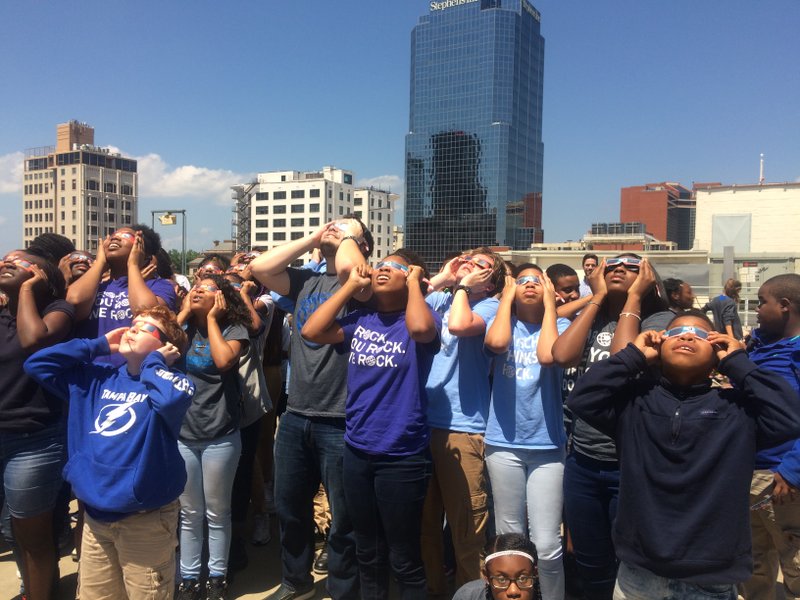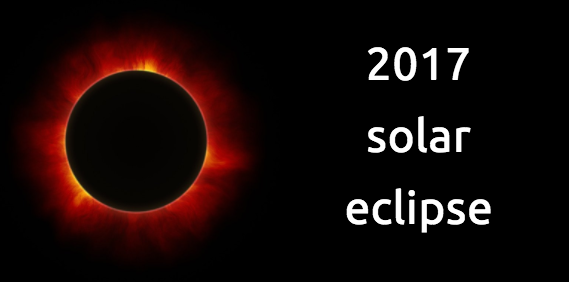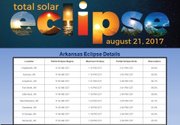3:49 p.m. UPDATE » Americans are dazzled as eclipse turns day into night
Millions of Americans gazed in wonder through telescopes, cameras and disposable protective glasses Monday as the moon blotted out the sun in the first full-blown solar eclipse to sweep the U.S. from coast to coast in nearly a century.
"It was a very primal experience, it really was," Julie Vigeland, of Portland, Ore., said after she was moved to tears by the sight of the sun reduced to a silvery ring of light in Salem. "I've seen other really magnificent things, but there is nothing, nothing like this. Absolutely nothing."
The temperature dropped, birds quieted down, crickets chirped and the stars came out in the middle of the day as the line of darkness raced 2,600 miles across the continent in about 90 minutes, bringing forth oohs, aahs, shouts and screams.
In Boise, Idaho, where the sun was more than 99 percent blocked, people clapped and whooped, and the street lights came on briefly, while in Nashville, Tenn., people craned their necks at the sky and knocked back longneck beers at Nudie's Honky Tonk bar.
Passengers aboard a cruise ship in the Caribbean watched it unfold as Bonnie Tyler sang her 1983 hit "Total Eclipse of the Heart."
At the Nashville Zoo, the giraffes started running around crazily in circles when darkness fell, and the flamingos huddled together, though zookeepers aid it wasn't clear whether it was the eclipse or the noisy, cheering crowd that spooked them.
Several minor-league baseball teams — one of them, South Carolina's Columbia Fireflies, outfitted for the day in glow-in-the-dark jerseys — briefly suspended play.
At the White House, despite all the warnings from experts about the risk of eye damage, President Donald Trump took off his eclipse glasses and looked directly at the sun.
Read Tuesday's Arkansas Democrat-Gazette for full details.
— The Associated Press
[2017 SOLAR ECLIPSE: Live video, events, updates + more]
3:30 p.m. UPDATE » Rare solar eclipse brings mass of spectators to Little Rock's River Market
Onlookers paraded through Little Rock’s River Market with their eyes to the heavens as one of two solar eclipses set within the next decade touched off a torrent of attention and intrigue.
2:10 p.m. UPDATE » Total solar eclipse in U.S. comes to end in South Carolina
The first total solar eclipse to sweep the U.S. coast to coast in nearly a century has come to an end in South Carolina.
Americans across the land watched in wonder Monday as the moon blocked the sun, turning daylight into twilight.
Totality — when the sun is completely obscured by the moon — lasted just two minutes or so in each location along the narrow corridor stretching all the way across the U.S., from Oregon to Charleston, South Carolina. It took about 90 minutes for total blockage to cross the country.
Two-hundred million people live within a day's drive of Monday's path of totality. So towns and parks along the eclipse's main drag have welcomed monumental crowds. The last coast-to-coast eclipse was in 1918.
— The Associated Press
2:05 p.m. UPDATE » EStem students watch eclipse from downtown parking garage rooftop
As the partial solar eclipse neared its peak at 1:18 p.m., the director of eStem Junior High School began to look concerned.
“I think some of them thought there would be more,” Jarrod DuPriest said. “Maybe we should have been more clear.”
There were about 200 seventh and eighth graders sitting behind him on the rooftop of a parking garage in downtown Little Rock .
“I thought it was going to get dark,” Julia Hogue, 12, said. “I didn’t know until a few minutes ago that this was it.”
Still, she added, it was exciting nonetheless.
“It was lit,” one 12-year-old said.
“Literally,” another added.
— Kally Patz
2 p.m. UPDATE » Eclipse doesn't faze zoo animals
During peak coverage of the solar eclipse, a crowd of Little Rock Zoo visitors turned their faces to a darkened sky while the primates around them snoozed.
About two dozen people walked to the Great Ape area of the Little Rock Zoo to watch Monday's eclipse.
Click here for more details from the Little Rock zoo viewing.
1:30 p.m. UPDATE » Eclipse reaches maximum coverage in Little Rock
The eclipse has reached maximum coverage in Little Rock.
Sky watchers in Arkansas' capital city saw about 89 percent of the sun obscured by the moon at 1:18 p.m. The process then began to reverse with more of the sun gradually revealing itself from that point on.
Points across Arkansas received their maximum eclipse — ranging from 83 percent in El Dorado to 97 percent in Corning — either minutes before or minutes after Little Rock.
In downtown Little Rock, watchers wore special glasses and gathered on parking decks and building rooftops to see the partial eclipse.
1:10 p.m. UPDATE » Some flock to Little Rock Zoo to see animals experience eclipse
Dozens of people flocked to the Little Rock Zoo to see if the animals there would stir or sleep during Monday's eclipse.
Arkansas first made contact with the total eclipse around 11:45 a.m. in the northwest corner of the state. The eclipse then swept across the rest of the state.
In preparation, the Little Rock Zoo ordered a few hundred eclipse glasses to pass out to visitors beginning Monday morning, Director Susan Altrui said. They were gone by 12:30 p.m.
"That's so cool!" exclaimed one zoo-goer as she donned her gifted glasses and looked skyward at a bright sun.
Staffers also encouraged people to download an app called iNaturalist where users record their observations about the birds and beasts that may act differently in darkness, Altrui said.
Zoo educators Katy Holloway, Steven Lemp and Laura Fawks patrolled zoo grounds, explaining the app and reminding young guests not to look directly at the sun.
Some nocturnal animals might start their nightly routine a little early, Holloway said. Others animals chirp or bleat. Or they could do nothing, she said. Research on animal behavioral changes during solar eclipses is scant.
Researchers can use the information collected on the iNaturalist app to find new information about what animals do when day turns, temporarily, to night, Holloway said.
While awaiting the impending peak obscurity, people watched primates vault over each other in what Holloway described as a play for dominance. They howled and fought, though Lemp assured guests that was typical monkey business and not special for the eclipse.
Zoo-goer Kate Henning camped out under a canopy near the chimpanzee exhibit. She chose the zoo as her eclipse-viewing destination because she wanted some insight into how it would "feel if we didn't know it was coming," she said.
Thousands of years ago, humans had no idea they would plummet into darkness for a few brief moments. Henning said she wanted to observe an animal similar to people to watch how they react. She guessed the chimps would "chatter to each other, mostly."
Kim McClendon arrived with two of her friend's kids when the zoo doors opened, Korbin and Evie, in tow. She assumed the place would be packed but was pleasantly surprised, she said.
They journeyed to the elephants first, and they were the "first ones to act up," Korbin said.
They trumpeted softly, he said.
"It was funny."
— Emma Pettit
1 p.m. UPDATE » Eclipse nears maximum coverage in Little Rock
The eclipse will reach maximum coverage in Little Rock in less than 20 minutes.
In Arkansas' capital city, sky watchers can see about 89 percent of the sun obscured at 1:18 p.m. The sun is gradually becoming more blotted out as that time gets closer, but the process will slowly reverse after that time.
Looking at the sun without a special pair of glasses can be harmful, experts warn. Click here to watch a live stream of the eclipse.
11:48 a.m. UPDATE » Partial eclipse begins in Little Rock
The partial eclipse has begun in Arkansas according to a timeline put out by the National Weather Service of Little Rock.
Forecasters predicted the eclipse would first come in contact with northwest Arkansas at 11:43 a.m. Little Rock observers began to see the moon edge out the sun at 11:48 a.m., and the eclipse is expected to leave the state at 2:50 p.m.
Though partial in Arkansas, the moon will totally block the sun for less than three minutes elsewhere around the country. A strip of the contiguous United States will experience a total eclipse, an event that hasn’t happened in 99 years.
In the Natural State, the moon will obscure anywhere between 82 to 97 percent of the sun.
— Emma Pettit
8:50 a.m. UPDATE » Forecast in Arkansas calls for sunny skies
The predicted blend of sunny skies and muted clouds will make for prime eclipse viewing across Arkansas as the moon dims the sun midday Monday, according to the National Weather Service.
The Natural State will be mostly sunny when the moon blocks out most of the sun for up to 2 minutes and 40 seconds, said meteorologist Heather Cross with the agency's North Little Rock office. Skies are predicted to be clear with only spots of clouds during the entire eclipse event, which lasts from about 11:45 a.m. until 2:50 p.m. in Arkansas.
Though Arkansas will experience a partial eclipse, a sliver of the country will see total obscurity. A diagonal stretch of the continental United States from the northwest to the southeast will descend into darkness as the moon blocks the entire sun. The corona, a ring of plasma that extends thousands of miles off the sun’s surface, will be visible from Earth.
A total solar eclipse has not swept across the continental United States in 99 years.
Temperatures today will hover in the mid 80s to the low 90s, Cross said. During peak coverage, predicted to be around 1:20 p.m. for most of the state, temperatures will likely drop a few degrees, she said.
There may be a few clouds, but they are “definitely not going to obscure the view,” Cross said. Rain likely won’t be a factor either, she said. Central Arkansas has a less than 20 percent chance of precipitation, while western Arkansas is only slightly higher in the 20 to 30 percent range, she said.
National Weather Service offices around the country will be closely observing the phenomena, Cross said. Stations in Boise, Idaho, Nashville, Tenn., and Charleston, S.C. will launch hydrogen-filled weather balloons with an affixed sensor to continuously monitor temperature, pressure and relative humidity.
— Emma Pettit
8 a.m. UPDATE » Americans stake out prime viewing spots to see sun go dark
Americans with telescopes, cameras and protective glasses staked out viewing spots along a narrow corridor from Oregon to South Carolina to watch the moon blot out the midday sun Monday in what promised to be the most observed and photographed eclipse in history.
Sky-watchers everywhere — and millions were expected to peer into the sun — fretted about the weather and hoped for clear skies for the first total solar eclipse to sweep coast-to-coast across the U.S. in practically a century.
As he set up telescopes, Ray Cooper, a volunteer with the Oregon Museum of Science and Industry in Salem, worried offshore clouds might roll in and spoil the two-minute show.
"If it stays like this, it will be perfect," Cooper said on the eve of the big day. He has seen full solar eclipses before, but never so close to home, making this one extra special.
With 200 million people within a day's drive of Monday's path of totality, towns and parks braced for monumental crowds.
In Salem, a field outside the state fairgrounds was transformed into a campground in advance of an eclipse-watching party for 8,500, courtesy of the Oregon Museum of Science and Industry.
"It's one of those 'check the box' kind of things in life," said Hilary O'Hollaren, who drove 30 miles from Portland with her two teenagers and a tent, plus a couple friends.
Astronomers consider a full solar eclipse the grandest of cosmic spectacles.
The Earth, moon and sun line up perfectly every one to three years, briefly turning day into night for a sliver of the planet. But these sights normally are in no man's land, like the vast Pacific or Earth's poles. This is the first eclipse of the social media era to pass through such a heavily populated area.
The moon hasn't thrown this much shade at the U.S. since 1918. That was the country's last coast-to-coast total eclipse.
In fact, the U.S. mainland hasn't seen a total solar eclipse since 1979 — and even then, only five states in the Northwest experienced total darkness.
Scientist said Monday's total eclipse would cast a shadow that would race through 14 states, entering near Lincoln City, Oregon, at 1:16 p.m. EDT, moving diagonally across the heartland over Casper, Wyoming, Carbondale, Illinois, and Nashville, Tennessee, and then exiting near Charleston, South Carolina, at 2:47 p.m. EDT.
The next total solar eclipse in the U.S. will be in 2024. The next coast-to-coast one will not be until 2045.
— The Associated Press


